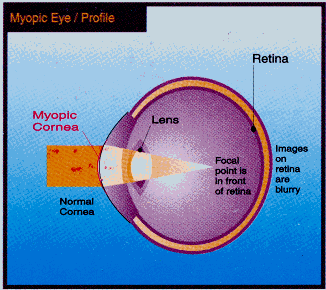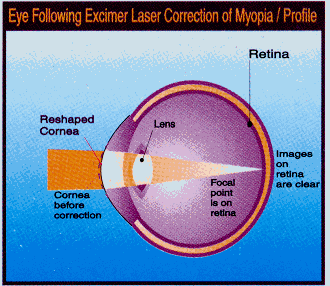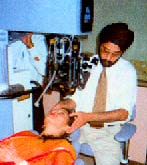
In a normal eye, the cornea and the lens focus the light rays entering the eye to a single point close to the retina. The retina, or the light sensitive tissue in the back of the eye, converts light impulses into nerve impulses. The nerve impulses move along the optic nerve to the brain which interprets the impulses allowing these persons to "see’. Three primary types of refractive errors may occur. These are myopia (near sightedness), hyperopia (far sightedness) and astigmatism.

A near sighted eye is usually longer than the normal eye and the light rays get focused at a single point in front of the retina. Hence, the resulting vision is not clear. As a result close objects can be seen better than those at a distance.
The objective of the Photo-Refractive Keratectomy (PRK) procedure is to reduce the curvature of central cornea (the transparent tissue that covers the front of the eye). The Excimer Laser beam is directed towards the cornea and removes a small layer of the central cornea (approximately 10%) starting from the centre of the eye and moving outwards. As the curvature of the central cornea is reduced, the light rays converge on the retina rather than in front of it, resulting in a reduction in near sightedness (or myopia). For correction of Astigmatism, the cornea is ablated in an elliptical manner using a specially and specifically designed ablatable mask. Similarly, for Hyperopia, a para-central ablation using a different mask is carried out. This results in steepening of the central cornea resulting in a decrease / removal of plus glasses.
The word "Laser" stands for "Light Amplification by Stimulated Emission of Radiation". Ordinary light is made up of a broad range of wavelengths and has relatively low wavelength in the light spectrum that can be focused into a small region. The Excimer Laser uses a mixture of argon and fluorine gases to produce a narrow uniform beam of invisible ultra violet light energy, which when focused through a lens system, produces vaporisation of corneal tissue. The Excimer Laser light energy does not produce heat, but breaks molecular bonds and vaporises tissues and few molecular layers at a time. This process is called photo-ablation. Excimer Laser PRK has brought about a revolution in the field of photo-refractive surgery. This procedure reduces reliance on or enables one to discontinue using corrective lenses for refractive disorders i.e. Myopia, Hyperopia and Astigmatism.
Excimer Laser refractive surgery (also called "corneal sculpting’) corrects refractive error by altering the shape of the cornea. Ultra’- violet light (193 mm) from the Excimer Laser hits the corneal surface and removes or ablates some corneal tissue, as per the type and extent of correction required.
There is virtually no damage to the cells surrounding the ablated tissue. This absence of damage is a major reason as to why the Excimer Laser is used for delicate eye procedures.
The patient should be 18 years or older and the vision over the last year should be stable. There should be no other associated corneal, ocular or systemic pathology. A thorough pre-operative assessment is carried out to exclude any of the above abnormalities.
PRK is performed as an outpatient procedure under topical anesthesia. The patient will be awake during the procedure. A sedative may be given to relax the patient. The system is then activated to perform the corneal sculpting. This procedure takes IS- 40 seconds. The total time taken including positioning of eye under the laser is about 10 minutes.

Photo-Refractive Keratectomy (PRK) is the treatment of choice over Radial Keratectomy (RK). The point in favor of PRK is it’s higher degree of predictability especially upped 8 dioptres of Myopia. This is because each individual pulse removes a specific amount (0.2- 1.0) microns) of corneal tissue. The resultant depth of ablation is more predictable and uniform as compared to RK. PRK also achieves earlier stability of refraction. Since surgical reliance is less, it is free of all complications associated with RK surgery like-infection, rupture of incision, etc. There are fewer incidences of glare and halos as compared to RK. Like any other procedure, PRK has its own side- effects i.e. pain for about 24-48 hrs, glare, foreign body sensation, corneal haze, light sensitivity etc. Haze occurs 3-4 weeks after treatment and gradually disappears with time.
The best results are seen upto powers of -8.0 dioptres. Although an attempt is made to achieve a post PRK refraction of 0, it cannot be guaranteed in all cases. The vast majority of the cases have a vision of 6112 or better without glasses after this procedure.The power of glasses post excirner is usually near zero or ± 1 dioptre in over 90% of the cases.
Excimer Laser is also used for removal of superficial corneal opacities which in the absence of Excinier Laser would require a corneal grafting as the treatment. This procedure is called as Photo-Therapeutic Keratectomy (PTK).

The Apollo Laser Vision Centre has installed the latest generation state-of- the-art Excimer Laser, that is the Summit SVS Apex Plus. The advantages of this laser include : (a) A long and well researched track record. (b) Largest series of cases being done with this laser in the world. (c) The only Excimer in Delhi to have passed the rigorous FDA (USA) approval. (d) This laser uses the unique niask technology which is fundamentally the best for correcting Astigmatism and Hyperopia. The Excimer procedure is being competitively priced at Rs. 10,000 for one eye and Rs. 19,000 for two eyes despite a total investrnnt of about 1.50 crore in the Apollo Laser Vision Centre. With the commissioning of this facility, the Department of Ophthalmology at Indraprastha Apollo Hospitals has acquired all the latest equipment and expertise for diagnosis and treatment of eye disorders by expert professional doctors.
(Also read LASIK)